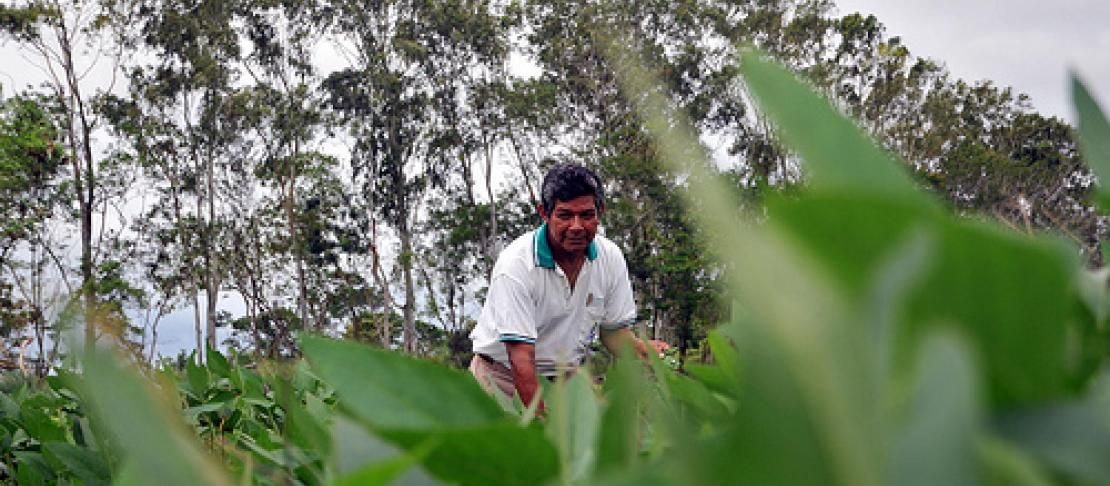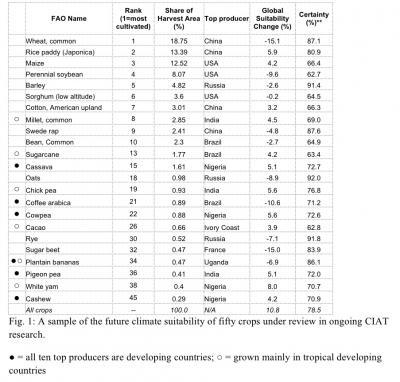The impacts of climate change on key crops: spotlight on ongoing research

Climate projections of higher temperatures and variable precipitation may seriously threaten some agricultural systems, which will be exposed to extremes that exceed their capacities to adapt.
Scientists at the International Center for Tropical Agriculture (CIAT) in Cali-Palmira, Colombia are working on research to show which crops will be affected and where. Their project examines the likely impacts of climate change on the 50 most globally important crops, determined by total harvest area. Initial results show a mixed bag of wins and losses, indicating the importance of investing in agricultural adaptation pathways to balance decreases in suitability for some crops or areas, with emerging opportunities in other potential croplands.
The results illustrate a general trend where, as the world warms, suitable growing areas will shift towards cooler temperatures at higher latitudes, where most developed countries are located. Therefore, while developed countries may gain substantial production potential, many developing countries—particularly those in food-insecure subtropical and tropical regions—will likely lose out. Unless farmers can migrate their crops to more viable growing areas, many food products grown exclusively or mainly in tropical climates, like Arabica coffee (10.6%) and plantain bananas (-6.9%), will become scarcer. Moreover, a significant proportion of food crops are currently produced in developing countries, and taking advantage of newly suitable croplands farther north would require agricultural systems in areas with currently little to no arable land. Such a process will take time and come at significant economic costs—and during this lag time, food security may be put at risk.
Thus far CIAT’s models have analyzed the impact of climate change in the hypothetical, best-case scenario of where crops can migrate without limit from low-suitability to high-suitability zones. The results show worrisome global decreases in suitability for key food crops like wheat (-15.1%) and soybean (-9.6%), the first and fourth most harvested crops, but also for less commonly cultivated crops like oats (-8.9%), rye (-7.1%), and sugar beet (-15.0%). The picture is rosier for other important foods like rice (+5.9%) and maize (+4.2%), as well as lesser-grown crops such as white yam (+8.0%) and common buckwheat (+9.7%). These figures represent a hypothetical, best-case scenario of unlimited migration of crops, from low-suitability to high-suitability zones. Notably, this would entail developing new agricultural systems in areas with currently little to no arable land.
Geographically, North Africa will likely be the most negatively impacted (80% of the crops show losses in suitability), while Asia, Australia, Europe, and North America have the most to gain. The Pacific Islands, the Caribbean, Latin America, and Sub-Saharan Africa will be negatively impacted as well, but their average change in crop suitability is lower than 5%.
These anticipated yield reductions bode poorly for many small producers in these regions, who generally demonstrate lower adaptive capacity, due to common infrastructural, managerial, and market access constraints. In Sub-Saharan Africa, for instance, production systems are highly sensitive to changes in precipitation because of scarce irrigation and drainage infrastructure. Consumers, too, may be affected by lower production and higher prices. In this way, climate change may further complicate food security and hunger issues precisely in the parts of the world where these stresses already exist.
The effects could also have severe repercussions for national economies, as negative impacts are also expected in cash crops like coffee and sugarcane, which contribute considerably to the gross domestic product of some countries.
However, given global gains in crop suitability, food security does not necessarily have to worsen. But responding to unprecedented and dynamic shifts in climate will require a wide range of tools, including technology and financial transfer; preparation for potential migration corresponding to geographical shifts in suitable areas; domestic, regional, and international cooperation and coordination.
Future plans for the ongoing research include the addition of a “no migration” scenario, which will present worst-case changes in crop suitability. The scientists also intend to define and prioritize breeding needs for the whole set of crops in the most affected growing environments. Finally, implications for food and nutritional security in the most impacted geographical areas will be assessed.

Click to enlarge the table
This ongoing research is led by Andy Jarvis, CIAT. Please leave a comment to get in touch.


